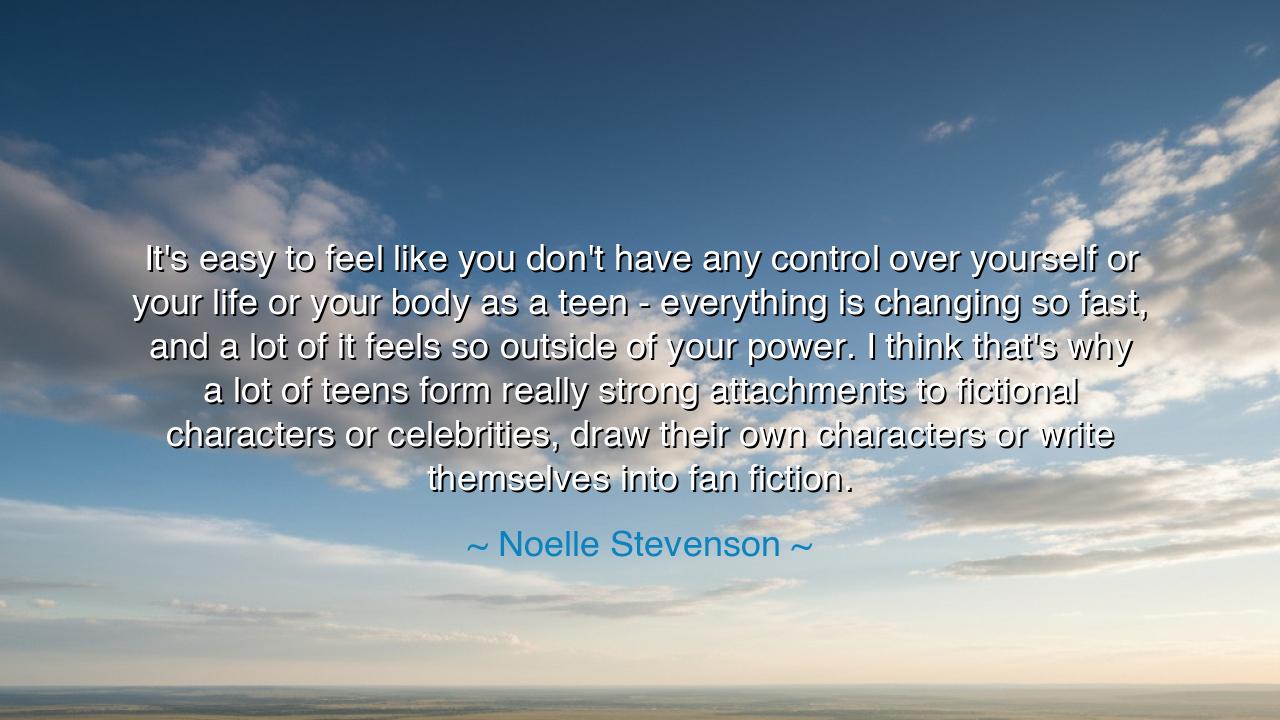
It's easy to feel like you don't have any control over yourself
It's easy to feel like you don't have any control over yourself or your life or your body as a teen - everything is changing so fast, and a lot of it feels so outside of your power. I think that's why a lot of teens form really strong attachments to fictional characters or celebrities, draw their own characters or write themselves into fan fiction.






Hearken, O children of the ages, to the penetrating words of Noelle Stevenson, who illuminates the turbulence of youth: “It’s easy to feel like you don’t have any control over yourself or your life or your body as a teen—everything is changing so fast, and a lot of it feels so outside of your power.” In her reflection, we perceive a timeless truth: adolescence is a crucible of transformation, where the self is in constant flux, and the young mind struggles to navigate forces that feel larger than comprehension or mastery.
Since antiquity, elders have recognized that the teen years are marked by uncertainty and instability. In the academies of Athens, young citizens wrestled with the lessons of philosophy, civic duty, and moral responsibility, often feeling the weight of change and expectation pressing upon them. Stevenson’s insight echoes this ancient wisdom: when one’s body, emotions, and identity are in constant evolution, the search for anchors—whether through admiration, creativity, or connection—is both natural and necessary.
Consider the story of Anne Frank, whose adolescence was shadowed by exile and danger. She found solace in writing, in imagining narratives, and in observing the characters of her own creation. By giving herself voice on paper, she reclaimed a measure of control over her world, constructing order and meaning amidst chaos. Similarly, Stevenson notes that teens are drawn to fictional characters or celebrities, drawing or writing themselves into fan fiction, as a means of shaping identity and reclaiming agency in a life that often feels imposed upon them.
Her reflection illuminates the therapeutic and creative power of imagination. To craft characters, to inhabit stories, or to emulate admired figures is not mere diversion—it is a rehearsal for life, a training in empathy, self-expression, and self-determination. In these acts, the adolescent asserts control, explores possibilities, and cultivates understanding, even when the external world feels overwhelming or unpredictable. The ancients understood this principle, using drama, poetry, and ritual to allow youth to practice mastery of emotion, action, and moral choice.
The lesson is profound: the attachments teens form to fictional worlds are not trivial; they are lifelines. They provide a sense of agency, identity, and belonging when external circumstances feel uncontrollable. By engaging with stories, drawing, or writing, youth practice autonomy and creativity, preparing themselves to navigate the complexities of adult life with insight, resilience, and emotional intelligence.
Practical guidance flows from this reflection. Encourage adolescents to explore creative outlets, whether through writing, drawing, performance, or fandom engagement. Recognize that these activities are more than pastime—they are instruments of emotional growth, self-understanding, and empowerment. Provide guidance, support, and space for such exploration, and honor the ways young people seek control and meaning in their evolving lives.
Stevenson’s words also remind us of the universality of this experience. Every generation of youth has grappled with the turbulence of adolescence, seeking anchors in stories, mentors, or heroes. By understanding this, elders, educators, and peers can provide support, guidance, and empathy, helping the young translate admiration and attachment into constructive growth and self-expression.
Thus, heed the eternal teaching of Noelle Stevenson: the teen years, though tumultuous and filled with change, are also ripe with opportunity for agency, creativity, and self-discovery. By embracing imagination, connecting with stories, and expressing oneself through art and narrative, the young reclaim power in a world that often feels uncontrollable. In this practice, they cultivate resilience, insight, and the enduring capacity to navigate life with wisdom, courage, and purpose.






AAdministratorAdministrator
Welcome, honored guests. Please leave a comment, we will respond soon